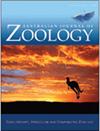Comparative echolocation and foraging ecology of horseshoe bats (Rhinolophidae) and Old World leaf-nosed bats (Hipposideridae)1
IF 1
4区 生物学
Q3 ZOOLOGY
引用次数: 5
Abstract
Horseshoe (Rhinolphidae) and Old World leaf-nosed (Hipposideridae) bats are high duty cycle (HDC) echolocators sharing a suite of adaptations including long duration signals relative to their signal periods, peak energy concentrated in a narrow spectral band dominated by a constant frequency (CF) component, ‘auditory fovea’ (over-representation and sharp tuning of neurons responsible for frequencies at or around the CF) and ability to compensate for Doppler shifts in echoes. HDC bats separate signals from returning echoes in the frequency domain. Rhinolophids are more specialised neurobiologically than hipposiderids, producing longer duration signals at higher duty cycles, and have narrowly tuned auditory fovea and almost full Doppler shift compensation. Here, I examine whether these differences have produced ecological divergence between the families by testing predictions of differences in prey perception, prey capture behaviour, foraging habitat and diet. I found no discernible differences in these variables between the two families. Rhinolophids and hipposiderids both forage close to vegetation, capture prey by aerial hawking and gleaning from surfaces, and consume mostly flying insects with spiders and terrestrial, flightless arthropods taken occasionally. The data presented here show that the two families are similar in foraging ecology despite differences in echolocation and audition.马掌蝠与叶鼻蝠回声定位及觅食生态学的比较
马蹄铁蝠(鼻蝠科)和东半球叶鼻蝠(马尾蝠科)是高占空比(HDC)回声定位器,它们共享一套适应性,包括相对于它们的信号周期而言持续时间较长的信号,峰值能量集中在由恒定频率(CF)成分主导的窄频谱带,“听觉中央凹”(负责CF或周围频率的神经元的过度表征和尖锐调谐)以及补偿回声多普勒频移的能力。HDC蝙蝠在频域将信号与返回的回声分开。鼻虫在神经生物学上比海马类动物更专一,在更高的占空比下产生更长的持续时间信号,并且有狭窄的听觉中央凹和几乎完全的多普勒频移补偿。在这里,我通过测试对猎物感知、猎物捕获行为、觅食栖息地和饮食差异的预测,来研究这些差异是否导致了这些科之间的生态差异。我发现两个家庭在这些变量上没有明显的差异。鼻科动物和海马科动物都在靠近植被的地方觅食,通过空中叫食和从表面拾取食物来捕捉猎物,它们主要吃飞虫,偶尔吃蜘蛛和不会飞的陆生节肢动物。这里的数据表明,尽管在回声定位和听觉上存在差异,但这两个科在觅食生态上是相似的。
本文章由计算机程序翻译,如有差异,请以英文原文为准。
求助全文
约1分钟内获得全文
求助全文
来源期刊
CiteScore
2.40
自引率
0.00%
发文量
12
审稿时长
>12 weeks
期刊介绍:
Australian Journal of Zoology is an international journal publishing contributions on evolutionary, molecular and comparative zoology. The journal focuses on Australasian fauna but also includes high-quality research from any region that has broader practical or theoretical relevance or that demonstrates a conceptual advance to any aspect of zoology. Subject areas include, but are not limited to: anatomy, physiology, molecular biology, genetics, reproductive biology, developmental biology, parasitology, morphology, behaviour, ecology, zoogeography, systematics and evolution.
Australian Journal of Zoology is a valuable resource for professional zoologists, research scientists, resource managers, environmental consultants, students and amateurs interested in any aspect of the scientific study of animals.
Australian Journal of Zoology is published with the endorsement of the Commonwealth Scientific and Industrial Research Organisation (CSIRO) and the Australian Academy of Science.

 求助内容:
求助内容: 应助结果提醒方式:
应助结果提醒方式:


